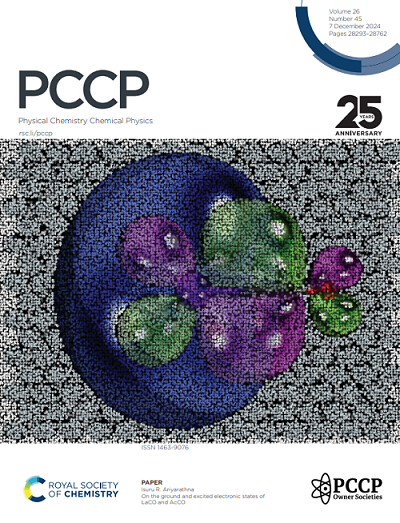The effect of Electron doping in non magnetic YH3 Leading to Room Temperature Ferromagnetism and Flat Band: Insights from Density functional theory
IF 2.9
3区 化学
Q3 CHEMISTRY, PHYSICAL
引用次数: 0
Abstract
Here, we present the induced room temperature d0ferromagnetism for YH3 doped with B (2 µB per defect magnetic moment) with the aid of Density Functional Theory (DFT) simulations. The prediction of d0 ferromagnetism in non-magnetic YH3 by Generalized Gradient Approximationfunctional has been further confirmed with the help of hybrid HSE06 functional. Interestingly, B doping in the system lead to appearance of flat band which may be attributed due to electron doping in the system. The presence of flat band on the Fermi level may lead to stable ferromagnetism in the system. We found that with a single B atom having impurity concentration of 1.04 at%, YH3 attains 2.0 µB magnetic moment per defect. The partial density of states along with spin-density plot implies that the induced magnetic moment is the result of interaction between the localized 2p, and 4d orbitals of the impurity B and host Y atoms with doped system satisfying the Stoner criteria for induced ferromagnetism. The presence of ferromagnetism in the system at room temperature has been estimated by calculating the Curie temperature, which is around Tc = 510 K by using mean field approximation. The thermodynamic and dynamic stability of the system at 25GPa has been confirmed with the Ab-initio MD and phonon dispersion. All these outcomes indicate the experimental feasibility of the system as a spintronic device and we also propose that electron doping may be a possible route to design material interesting properties.在此,我们借助密度泛函理论(DFT)模拟,介绍了掺杂 B(每个缺陷磁矩 2 µB)的 YH3 的室温 d0 铁磁性。在混合 HSE06 函数的帮助下,利用广义梯度近似函数预测的非磁性 YH3 中的 d0 铁磁性得到了进一步证实。有趣的是,在体系中掺入 B 会导致出现平带,这可能是由于体系中掺入了电子。费米级上平带的出现可能会导致该体系具有稳定的铁磁性。我们发现,单个 B 原子的杂质浓度为 1.04 at%,YH3 每个缺陷的磁矩为 2.0 µB。部分状态密度和自旋密度图表明,诱导磁矩是杂质 B 原子和主 Y 原子的局部 2p 和 4d 轨道相互作用的结果,掺杂系统满足诱导铁磁性的斯托纳标准。通过平均场近似计算居里温度(约为 Tc = 510 K),估算出该体系在室温下存在铁磁性。通过 Ab-initio MD 和声子色散,证实了该体系在 25GPa 下的热力学和动力学稳定性。所有这些结果都表明了该系统作为自旋电子器件的实验可行性,同时我们还提出,电子掺杂可能是设计材料有趣特性的一条可行途径。
本文章由计算机程序翻译,如有差异,请以英文原文为准。
求助全文
约1分钟内获得全文
求助全文
来源期刊

Physical Chemistry Chemical Physics
化学-物理:原子、分子和化学物理
CiteScore
5.50
自引率
9.10%
发文量
2675
审稿时长
2.0 months
期刊介绍:
Physical Chemistry Chemical Physics (PCCP) is an international journal co-owned by 19 physical chemistry and physics societies from around the world. This journal publishes original, cutting-edge research in physical chemistry, chemical physics and biophysical chemistry. To be suitable for publication in PCCP, articles must include significant innovation and/or insight into physical chemistry; this is the most important criterion that reviewers and Editors will judge against when evaluating submissions.
The journal has a broad scope and welcomes contributions spanning experiment, theory, computation and data science. Topical coverage includes spectroscopy, dynamics, kinetics, statistical mechanics, thermodynamics, electrochemistry, catalysis, surface science, quantum mechanics, quantum computing and machine learning. Interdisciplinary research areas such as polymers and soft matter, materials, nanoscience, energy, surfaces/interfaces, and biophysical chemistry are welcomed if they demonstrate significant innovation and/or insight into physical chemistry. Joined experimental/theoretical studies are particularly appreciated when complementary and based on up-to-date approaches.
 求助内容:
求助内容: 应助结果提醒方式:
应助结果提醒方式:


